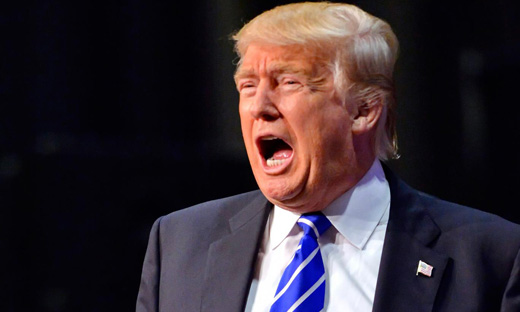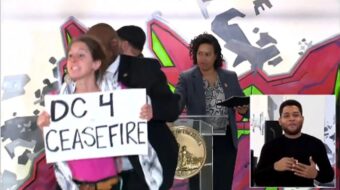
With Donald Trump’s new TV ad out this week, the “F” word – fascism – is once more being bandied about. Ever since Trump first started pontificating on his plans for a Mexican wall there have been discussions about whether his anti-immigrant rhetoric constituted something qualitatively different than your run of the mill Republican boilerplate. Commentaries have been penned, debates have taken place, and warnings have been issued. Everyone, whether on the left or the right, seems to be wondering: is he a fascist? He’s got the support of former KKK leader, David Duke; that’s got to count for something, right?
The Republican front-runner’s renewed pledge to shut out all Muslims from entering the U.S., his promise to use stronger military action to “cut the head off ISIS,” and the guarantee that Mexico will be bullied into paying for his wall certainly seem reminiscent of the 1930s fascist dictators we know from history. And even though some on the left have had a bad habit in the past of applying the label to opponents a little too liberally, the Trump-fascist comparison is one that a lot of people have been making over the last several weeks.
Presidential candidate Martin O’Malley has denounced Trump as a “fascist demagogue.” In Slate magazine, Jamelle Bouie believes Trump’s rhetoric and policies fit the fascist bill. The only thing still missing, he says, is the violence. Meanwhile, in a debate over at Jacobin, Richard Steigmann-Gall says that if we look beyond the obvious markers of historical fascist movements like matching shirts and armbands, then a lot of Trump’s message indeed harkens back to that past.
Another contributor, Jennifer Roesch, argues that too much time is being spent on the Trump-fascist discussion and that it is simply a distraction that feeds into “lesser evilism” and “trailing the Democratic Party further to the right.” Hmm…I wouldn’t have expected the debate to go that way, but okay.
It is not just Democratic presidential hopefuls, the liberal intelligentsia, or socialists making the fascist comparison though. Trump’s own GOP competitors have been among the quickest to hurl the fascist epithet at him. Rubio advisor Max Boot recently tweeted: “Trump is a fascist. And that’s not a term I use loosely or often. But he’s earned it.” Over in the Bush camp, national security advisor John Noonan also took to social media to denounce Trump’s supposed fascist leanings, declaring: “Forced federal registration of U.S. citizens, based on religious identity, is fasicm [sic]. Period. Nothing else to call it.”
All of these folks might be onto something. But then again, they might not. Trump’s bombastic rhetorical style, the jingoistic and racist content of his messaging, and the apparent willingness of his supporters to engage in at least a little bit of violence when someone speaks up too loudly at his rallies all make for easy comparisons to Hitler’s Brownshirt spectacles or Mussolini’s theatrical performances on the balcony in Rome. But beyond those few superficial observations, what is the structural and political basis for a successful fascist movement in today’s United States?
To properly categorize the Trump phenomenon and make a useful comparison to fascism, it is necessary get a grip on what fascism really entails. In thinking about the question, it is useful to look at what some anti-fascist leaders of the past had to say on the subject. These are the people who fought against the dictators, built broad popular movements of resistance, and in some cases gave their lives in the struggle to stop fascism.
One of the classic texts that helped unite the mass anti-fascist movements of the 1930s was a book by Georgi Dimitrov, a Bulgarian leader, titled Against Fascism and War. After Hitler and the Nazis burned down the Reichstag and tried to frame up left-wing activists, Dimitrov was one of the primary defendants in the trials that followed. In a report that incorporated the experiences of anti-fascist fighters from many countries, Dimitrov commented on the manner in which fascists tailored their appeal to the suffering and insecurity people were feeling during the Depression. He wrote:
“Fascism is able to attract the masses because it demagogically appeals to their most urgent needs and demands. It not only inflames prejudices that are deeply ingrained in the masses, but also plays on their sense of justice… it presents itself to the masses in the guise of champion of an ill-treated nation, and appeals to outraged national sentiments.”
While locked up in Mussolini’s jails, the Italian communist Antonio Gramsci wrote in his Prison Notebooks that fascist leaders appeal to people “by means of moralizing sermons, emotional stimuli, and messianic myths of an awaited golden age, in which all present contradictions and miseries will be automatically resolved and made well.”
So far, it seems Trump is checking a lot of boxes. What else is the “Make America Great Again” slogan if not the nationalistic championing of a country supposedly neglected and betrayed by its leaders? And is there any problem facing the country – from immigration to the economy to ISIS – which Trump’s managerial know-how cannot somehow magically fix?
But are racism and ultranationalism enough to qualify a politician or his group of supporters as fascist? We’ve had such movements a number of times in U.S. history. There was Father Coughlin, George Wallace, Pat Buchanan, and many others. At some point we will have to start asking about the material conditions that make it possible for fascist or proto-fascist movements to succeed.
If we confine ourselves to rhetoric and style alone, the fascist comparison might make some sense. However, the well-known examples of Hitler and Mussolini might be the wrong place to start. Instead of looking to the dictators of Germany or Italy, maybe a better parallel for the Trump phenomenon would be one of the wannabe dictators of the inter-war period. Someone like Sir Oswald Mosley, the leader of the British Union of Fascists in the 1930s.
Like Trump, Sir Oswald came from money. Big money. Both inherited real estate empires from their fathers. The flair of high society life, an unparalleled self-confidence, and a willingness to resort to gutter politics are other traits the two share. They see themselves, in the words of Gramsci, as “men of destiny.”
Mosley’s fascism was a caricature of the continental dictators, at least on the surface. He modeled his speaking style on Mussolini and copied the uniforms for his personal army of Blackshirt supporters from Hitler’s SS. If the appearance of his movement was little more than spectacle, his program was far more serious and dangerous. Mosley offered a technocratic and managerial state that would solve all problems, railed against “foreigners” and “alien interests,” and promised to make Britain great again.
I draw attention to the Mosley example not to argue that Trump too is a fascist. He definitely tries to fit the strongman mold, but that is not really the issue here. What really matters is the fact that the political-economic situation of America in 2016, like Britain in 1936, does not fit the pattern of Italy and Germany in the interwar years. That is what is most important when considering the question of whether Trump’s movement has the potential for fascism.
Returning again to Dimitrov, it is necessary to understand both what fascism is and why it arises when it does. He called it “the open terrorist dictatorship of the most reactionary, most chauvinistic” elements of capital. “The accession to power of fascism,” he wrote, “is not an ordinary succession of one…government by another, but a substitution of one state form of class domination…by another form – open terrorist dictatorship.”
Fascists, he argued, come to power as a party of attack against a powerful left and working class movement. It is the trump card (forgive the pun) of capital in its fight to block progressive and democratic advances. Most elements of big business don’t embrace fascism happily; they accept it as a last resort.
Gramsci said that although the recipe for fascist success in every country where it came to power was the same: “the crisis of the ruling class’s hegemony.” When the “huge masses have passed suddenly from a state of political passivity” into action against the big capitalists, the latter will then seek relief from “Caesarism” or “Bonapartism”, i.e. they will turn to a fascist strongman.
Whether you look at Italy in 1922, Germany in 1933, or Spain in 1936 – in every case there were mass militant movements of the left that were gaining power making radical changes possible. It was only when the democratic parliamentary systems could no longer guarantee the continued dominance of capital that fascist alternatives grew and were eventually accepted or even embraced.
This is where our fascist comparison starts to get a little shaky. Mass movements of the left have historically arisen during times of severe economic crisis and/or social dislocation. Although we have just lived through the Great Recession over the past several years, we have not seen the development of a mass transformative movement capable of challenging U.S. financial and corporate power. And that is the primary reason why the fascist danger is more of a rhetorical than a material one.
Just as British capitalism didn’t need a fascist dictator to survive in the 1930s, neither does contemporary U.S. capitalism. Trump, even if by some awful turn of events he becomes president, will almost certainly not be a fascist of the classical type. On the left, we might at least take some comfort in this fact.
But in a certain way, it also calls attention to our own inadequacies. The reality is that the left in the United States today remains rather weak. For years, it has only ever partially been able to offer effective leadership on the major political and economic issues of the day. Many advances have been made during the Obama presidency, but can we honestly attribute those to the militant action and leadership of the left? In far too many cases, the answer has to be a resounding “no”.
The existing structures of financial and corporate power are under no serious threat. Occupy Wall Street may have chipped away at the edges and sparked a new socialist consciousness. The Bernie Sanders campaign is keeping questions of economic justice on the agenda. And Black Lives Matter has brought the reality of institutional racism back into the spotlight. But can we yet say that any of these developments, whether considered alone or together, constitute a transformative power able to dramatically alter the course of U.S. capitalism? No, not yet at least.
That is why, if we do find recourse to the fascist creed when evaluating Trump, we should look to the examples of unsuccessful fascism. Look to the Mosley case in Britain. Trump is no Hitler. He’s neither a Mussolini, nor a Franco. Trump, like Mosley, is an imitation of the real thing.
Arguing that fascism of the classical style is unlikely should not, however, be taken as a signal that progressives can let their guard down. The stakes are still far too high for that.
If Trump does prevail in the GOP primaries and manages to secure the nomination, the political situation will change for progressives in perhaps unexpected ways. For starters, it is not altogether certain that the rest of the Republican establishment will throw their full support behind Trump. Whether that would actually manifest in an attempt by the party to sabotage his campaign or an effort to force him into a third party run, it is hard to predict. What is likely, however, is that the camp of reaction will be split, requiring the left to recalculate the political situation.
One thing is certain, though. With a Trump-led Republican Party, all the most racist and violent elements, which under normal circumstances operate just outside the bounds of respectable politics, will feel emboldened to come out of the shadows. The armed militia takeover in Oregon, the increasing number of physical attacks on immigrants and people of color around the country, and the acceptability of racist rhetoric in recent months are all signs that this is already occurring.
Even without Trump, a lot of this will probably happen anyway, as all of the GOP candidates have continued to flirt with their reactionary Tea Party and ‘Patriot’ fringe elements. While it would be a mistake to rush in applying the fascist label, it is important to see that while Trump’s campaign represents the most openly racist segment of the Republican Party, all the other candidates are cut from the same cloth.
Whether it is Cruz, Rubio, Christie, Bachmann, Bush, or any of the others, the same basic program guides each and every one of them. Their delivery may sound less harsh, but they all read from the same playbook as Trump.
**For readers looking for more information and resources on fascism, the two books referenced above, Dimitrov’s Against Fascism and War and Gramsci’s Selections from the Prison Notebooks, are both available from International Publishers.
Photo: AP












Comments